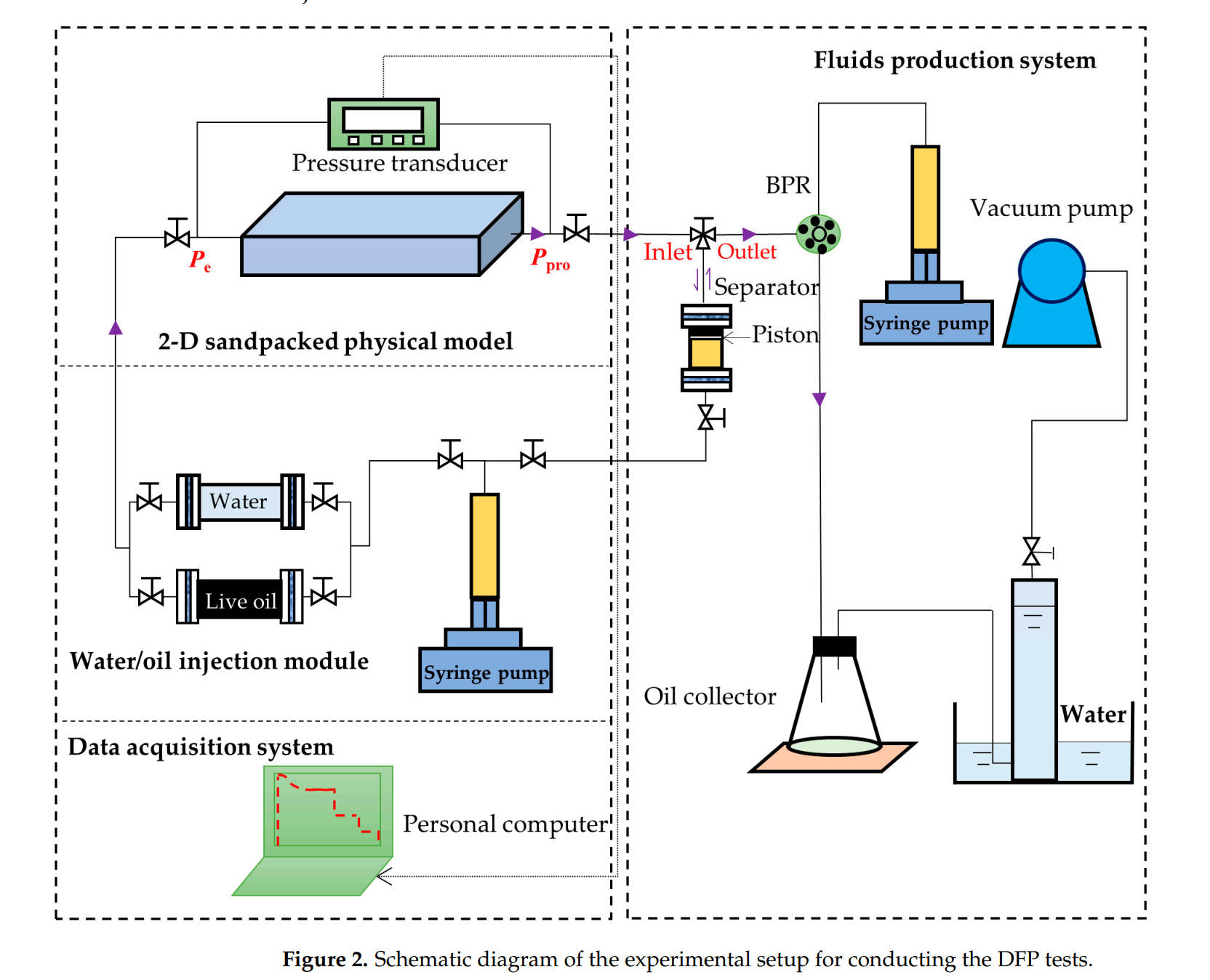Solvent Exsolution and Liberation from Different Heavy Oil–Solvent Systems in Bulk Phases and Porous Media: A Comparison Study
本文通过实验和数值研究,区分了不同原油-溶剂体系(原油-CO2、原油-CH4 和原油-C3H8)在本体相和多孔介质中的溶剂萃取和释放过程。实验上,作者在PVT单元中进行了两组恒定组成膨胀(CCE)测试,并在填沙模型中进行了差分流体生产(DFP)测试,比较了这些测试的结果。
实验结果表明,在多孔介质中,每个原油-溶剂体系的溶剂萃取发生在更高的压力下。在多孔介质中测量的原油-CO2、原油-CH4 和原油-C3H8体系的气泡成核压力(Pn)分别比本体相中的高0.24 MPa、0.90 MPa 和 0.02 MPa。此外,发现CH4气泡的成核比CO2或C3H8气泡更为即时。数值上,作者使用了商业CMG-STARS模块中的稳健动力学反应模型来模拟CCE和DFP测试中的气体萃取和释放过程。数值模拟中获得了气体萃取(rffe)和释放(rffl)的反应频率因子。发现在多孔介质中的测试相较于本体相中的测试具有更高的rffe值,表明多孔介质的存在促进了气体的萃取。三种不同的原油-溶剂体系的rff e大小顺序在本体相中为CO2 > CH4 > C3H8,在多孔介质中为CH4 > CO2 > C3H8。因此,CO2在本体相中最容易从原油中萃取,而CH4在多孔介质中最容易从原油中萃取。在三种溶剂中,CH4在DFP测试中最难从原油中释放,具有最低的rff l值为0.00019 min−1。研究表明,重油储层中的泡沫油演变过程与PVT测试等本体相测试中观察到的有很大不同。
CMG软件的应用情况:
在本研究中,使用了CMG-STARS模块中的动力学反应模型来模拟CCE和DFP测试中的气体萃取和释放过程。数值模拟用于获得在不同测试条件下的泡沫油形成和演变过程的定量结果。通过调整反应频率因子(rffe 和 rffl),模拟结果能够与实验数据相匹配,从而验证了模型的准确性和可靠性。
Abstract:
In this paper, experimental and numerical studies were conducted to differentiate solvent exsolution and liberation processes from different heavy oil–solvent systems in bulk phases and porous media. Experimentally, two series of constant-composition-expansion (CCE) tests in a PVT cell and differential ffuid production (DFP) tests in a sandpacked model were performed and compared in the heavy oil–CO2 , heavy oil–CH4 , and heavy oil–C3H8 systems. The experimental results showed that the solvent exsolution from each heavy oil–solvent system in the porous media occurred at a higher pressure. The measured bubble-nucleation pressures (Pn) of the heavy oil–CO2 system, heavy oil–CH4 system, and heavy oil–C3H8 system in the porous media were 0.24 MPa, 0.90 MPa, and 0.02 MPa higher than those in the bulk phases, respectively. In addition, the nucleation of CH4 bubbles was found to be more instantaneous than that of CO2 or C3H8 bubbles. Numerically, a robust kinetic reaction model in the commercial CMG-STARS module was utilized to simulate the gas exsolution and liberation processes of the CCE and DFP tests. The respective reaction frequency factors for gas exsolution (rff e) and liberation (rff l ) were obtained in the numerical simulations. Higher values of rff e were found for the tests in the porous media in comparison with those in the bulk phases, suggesting that the presence of the porous media facilitated the gas exsolution. The magnitudes of rff e for the three different heavy oil–solvent systems followed the order of CO2 > CH4 > C3H8 in the bulk phases and CH4 > CO2 > C3H8 in the porous media. Hence, CO2 was exsolved from the heavy oil most readily in the bulk phases, whereas CH4 was exsolved from the heavy oil most easily in the porous media. Among the three solvents, CH4 was also found most difffcult to be liberated from the heavy oil in the DFP test with the lowest rff l of 0.00019 min −1 . This study indicates that foamy-oil evolution processes in the heavy oil reservoirs are rather different from those observed from the bulk-phase tests, such as the PVT tests.
Keywords: solvent exsolution and liberation; non-equilibrium phase behaviour; foamy-oil formation and ffow; heavy oil–solvent systems; heavy oil reservoirs


Figure 1. Schematic diagram of the experimental setup for conducting the CCE tests



5. Conclusions
In this paper, the solvent exsolution and liberation processes of three different heavy oil–solvent systems in the porous media and bulk phases were studied experimentally and numerically. The following conclusions can be drawn from this study:
- The measured bubble-nucleation pressures (Pn) for the heavy oil–CO2 system, heavy oil–CH4 system and heavy oil–C3H8 system in the porous media were 0.24 MPa, 0.90 MPa and 0.02 MPa higher, respectively, than those in the bulk phases. This was because a lower supersaturation was needed for the bubble nucleation to occur in the porous media than that in the bulk phases.
- The measured total isothermal compressibility (ct) vs. test pressure (P) data in the heavy oil–CH4 system showed that the nucleation of CH4 bubbles was found to be more instantaneous than that of CO2 or C3H8 bubbles.
- Numerically, the obtained reaction frequency factors (rffe) for the gas exsolution were all higher in the tests with the porous media than those with the bulk phases for the three heavy oil–solvent systems. The higher rffe indicated that the dissolved gas was more readily to be exsolved from the heavy oil.
- The reaction frequency factors (rffl ) for the gas liberation in the heavy oil–C3H8 system with the porous media was found to be lower than that for the heavy oil–CO2 system, suggesting that the former system had more stable foamy oil than that in the latter system.
- The high rffe but low rff l in the heavy oil–CH4 system with the porous media showed that CH4 was an excellent solvent for inducing and maintaining foamy oil in the porous media.
作者单位:
里贾纳大学石油技术研究中心(PTRC),萨斯喀彻温省里贾纳,加拿大
